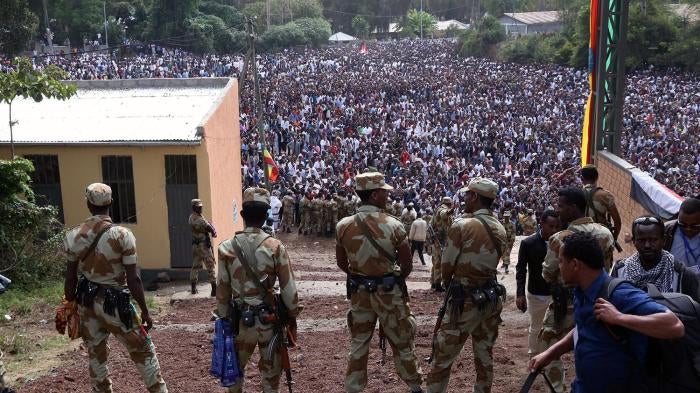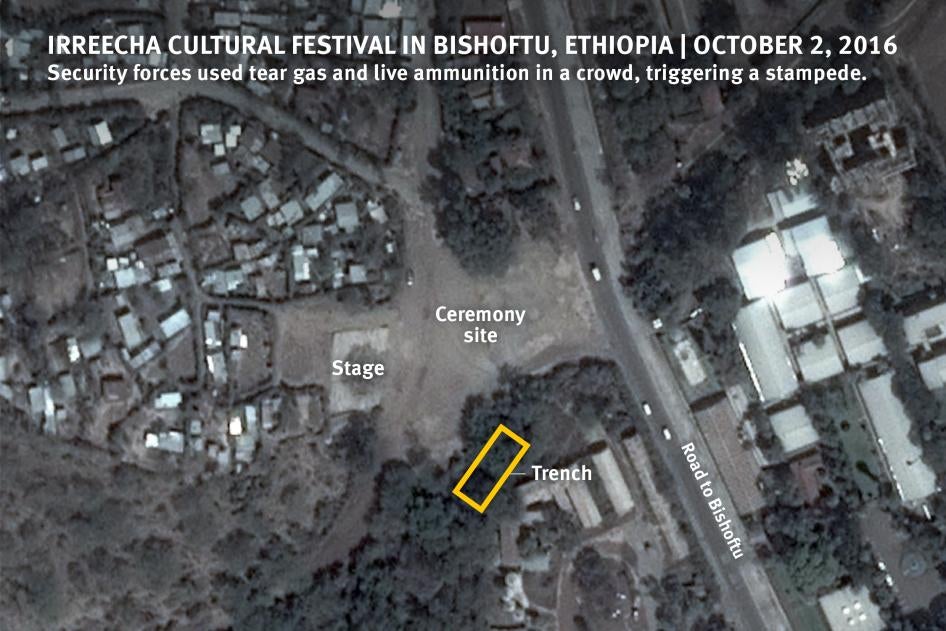(Nairobi) – Ethiopian government and security officials should act with restraint and take concrete steps to prevent injuries and deaths at this year’s Irreecha festival on October 1, 2017, Human Rights Watch said in a report and video released today. Many people, likely hundreds, died in a stampede at last year’s festival, triggered by security forces’ use of teargas and obstruction of exits.
The 33-page report, “‘Fuel on the Fire’: Security Force Response to the 2016 Irreecha Cultural Festival,” details the Ethiopian government’s use of force in response to restive crowds at 2016’s Irreecha. The festival, attended by massive crowds, is the most important cultural festival to Ethiopia’s 40 million ethnic Oromos, who gather to celebrate the end of the rains and welcome the harvest. Human Rights Watch found evidence that security force personnel not only triggered the stampede that caused many deaths but subsequently shot and killed some members of the crowd.
“The security forces’ disastrous and disproportionate use of force should not be repeated this year,” said Felix Horne, senior Africa researcher at Human Rights Watch. “With longstanding grievances still unanswered, this year’s Irreecha could be fraught with tensions. The government and the security forces should take all steps necessary before and during the festival to protect human life and de-escalate tensions.”
Human Rights Watch carried out more than 50 interviews in Ethiopia and abroad with attendees, witnesses, health workers, and others, and analyzed dozens of videos. Dozens of witnesses said they believed this was an intentional planned massacre by the government. Human Rights Watch has seen no evidence of that, but the perception, coupled with the past two years of brutality and unaddressed grievances, makes this year’s Irreecha a potential flashpoint, Human Rights Watch said.
Tensions were already high ahead of the 2016 festival – held every year at Bishoftu, 40 kilometers southeast of Addis Ababa – following a year of protests against the government and security force aggression that left more than 1,000 people dead and tens of thousands in detention. The government attempted to play a more central role in the management of the festival than in previous years, including imposing stringent security measures and flying military helicopters low overhead. A former traditional leader with close ties to the government appeared onstage.
All of this contributed to a tense and militarized air at a festival that had not in prior years had a significant security force presence. Shortly after the former traditional leader appeared, a man went on stage and shouted anti-government slogans. As the crowd grew more tense, security forces shot teargas, triggering a stampede, which left many dead.
Some people suffocated after falling into a nearby trench, while others were trampled in the ensuing chaos. Others fled toward nearby Lake Hora and drowned. Armed security forces were at the exits from the festival site, leaving those seeking to escape with few options. Numerous witnesses reported seeing dead bodies with bullet wounds in the stampede’s immediate aftermath. Two witnesses reported seeing plain clothes officers with pistols shooting at people during the stampede.
There were numerous protests around Bishoftu in the hours after the event. Witnesses said that people were killed with gunfire during these protests. In the week that followed, many people who attended Irreecha were arrested back in their home communities. Anger at the Irreecha deaths triggered unrest across Oromia as mobs of youths destroyed or looted government buildings and private businesses. On October 9, the government announced a far-reaching state of emergency that codified vague and overly broad restrictions on basic rights. The state of emergency was only lifted in August 2017.
26-year old Gemechu told Human Right Watch, “The 2016 Irreecha was different from what we know. We were already angry with the government from a year of protests, and when they tried to control our sacred event the crowd grew very angry – but we were still peaceful. The same soldiers who had been killing us during the year of protests fired teargas and bullets at Irreecha, triggering the stampede. It is their fault all those people died.”
No credible and independent investigation of the 2016 deaths has been carried out. The government has expressed condolences for the deaths but have stated that security forces were not armed, despite photographic and video evidence to the contrary. The prime minister congratulated security forces for their efforts to “maintain peace and order.” Government officials also have stated repeatedly that the situation was exacerbated by “anti-peace” elements in the crowd.
The government routinely blocks independent investigators, and does not cooperate with international mechanisms. The Ethiopian Human Rights Commission (EHRC), whose own investigation into the 2016 Irreecha was not credible, is affiliated with the government and is in no sense independent.
International guidelines, such as the United Nations Basic Principles on the Use of Force and Firearms, stipulate that security forces should seek to avoid the use of force and ensure that its use, where necessary, is strictly proportionate. Security forces should exercise restraint when using teargas in situations when its use could cause death or serious injury.
“Last year’s tragedy was triggered by the government’s botched effort to control the event,” Horne said. “This year, the government should consider whether a much lighter security force presence would best serve to minimize the potential for violence, and in any case, ensure that security force personnel minimize and seek to avoid any use of force.”












